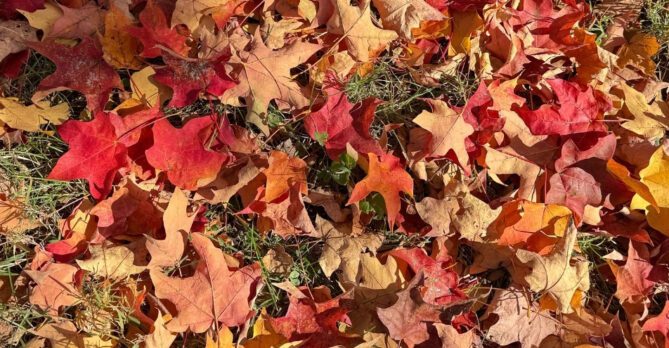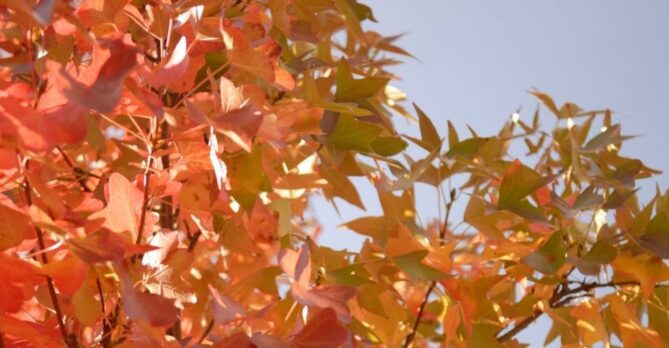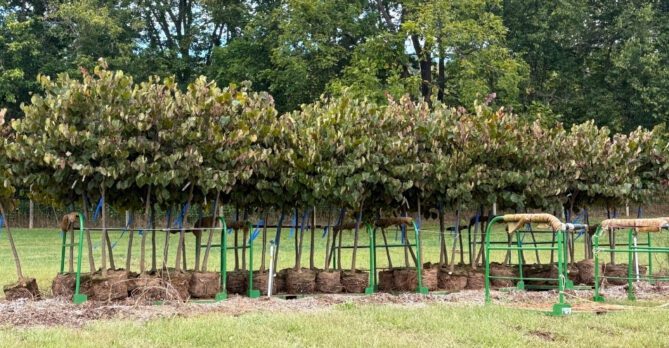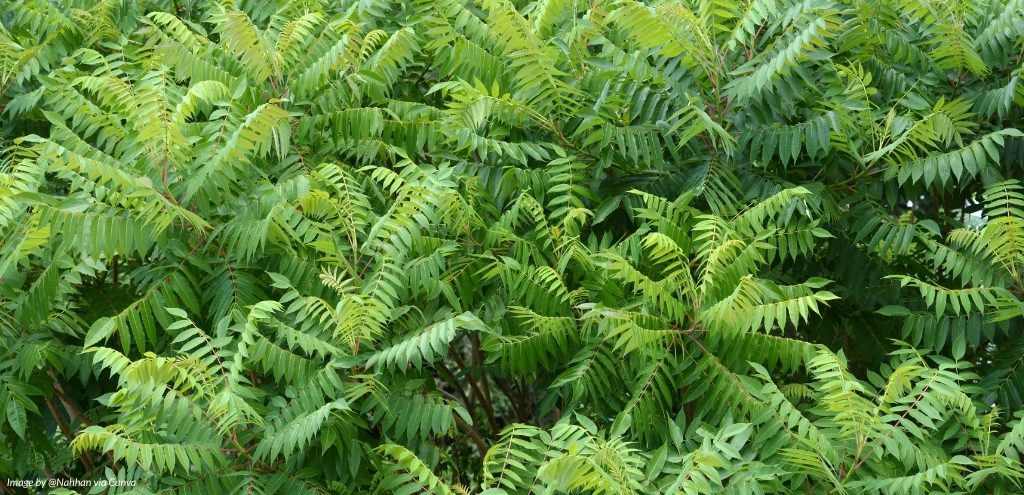
Smelling like burnt peanut butter, crowding out native species, and playing host to one of the most notorious invasive insects — the Tree of Heaven, Ailanthus altissima, is not as divine as it sounds.
A fast-growing deciduous tree native to China, the tree of heaven has permeated our environment and culture, emerging from the cracks in our sidewalks and the pages of our books ever since researchers first carried it to the present-day United States.
ORIGIN STORY
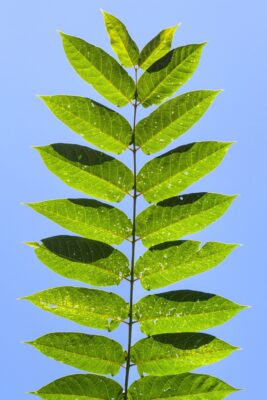
The tree of heaven was first brought to North America as a horticultural specimen and shade tree, establishing itself in the Philadelphia area in the late 1700s. With its rapid growth rate, tolerance of poor soil, and resistance to pests and air pollution, the tree quickly became a favorite in urban landscaping.
However, by the 1900s, the public turned against the tree of heaven, citing its foul odor, abundant seed production, and damage caused by its extensive root system.
But by then, the roots of the Ailanthus altissima had already spread far and wide. Across North America, the tree of heaven can be identified by its pinnately compound leaves (a leaf with a central stem and leaflets attached on each side), cantaloupe-like bark, and large clusters of yellow flowers and papery seeds that turn reddish over the course of the season. The tree of heaven, truly, shoots for the heavens, reaching heights upwards of 80 feet with canopies spreading wide and far.
WHY IS THE TREE OF HEAVEN SO INVASIVE?
Why is the tree of heaven so good at being invasive? For one, the tree can reproduce both sexually and asexually. It’s a prolific seed producer, with female specimens being known to produce as many as 300,000 seeds a year. Sprouts as young as two years old are also capable of producing seeds.
Moreover, mature trees of heaven continually spread through root suckers that can emerge as far as 50 feet from the original tree. Even if the tree is cut or injured, the Ailanthus altissima can still send up dozens of stump and root sprouts.
The tree of heaven is also a menace to its plant neighbors. The tree attacks native plants through a dual-pronged approach: crowding out other species with its dense thickets and secreting a natural, allelopathic chemical into the soil that is toxic, or herbicidal, to many plants. This aggressiveness can not only inhibit native species’ ability to grow nearby, but it can also kill the plants as well.
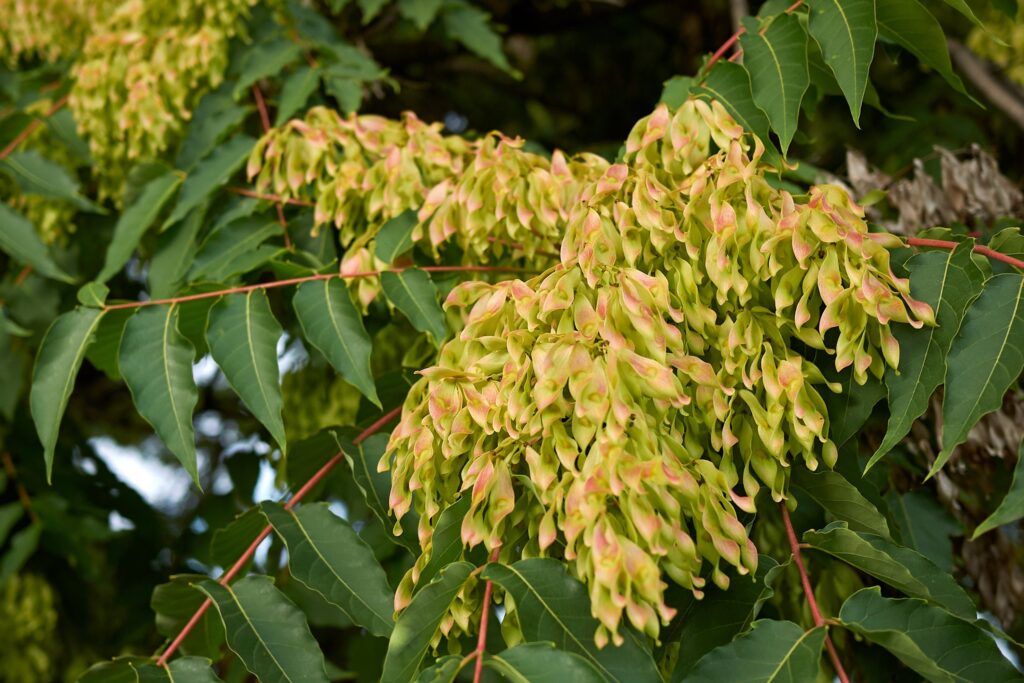
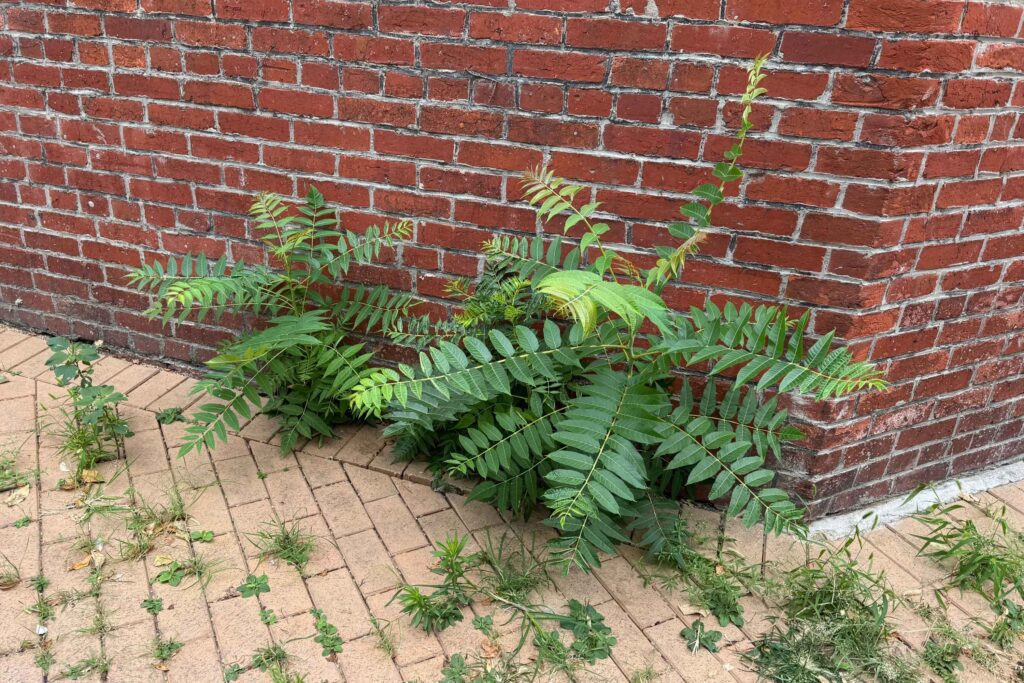
A MATCH MADE IN HEAVEN: SPOTTED LANTERNFLY AND AILANTHUS
The tree of heaven has recently been thrust into the spotlight thanks to another notoriously invasive specimen: the spotted lanternfly.
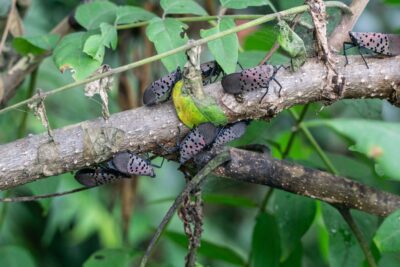
Since its discovery on American soil in 2014, the spotted lanternfly has spread rapidly, with infestations documented in over 15 states and DC. Chances are you’ve already spotted the dotted red bug, or maybe you’ve seen someone gleefully squishing one under their shoe.
While spotted lanternflies can feed on multiple kinds of trees, the tree of heaven is by far the most preferred host; nymphs and adults have higher survival rates and egg production when they feed on Ailanthus altissima compared to other tree species.
And remember that allelopathic, potentially toxic chemical the tree of heaven releases? The spotted lanternfly actually accumulates the chemical as it feeds on the Ailanthus altissima, making it unpalatable to predators and thereby increasing its success as an invasive species.
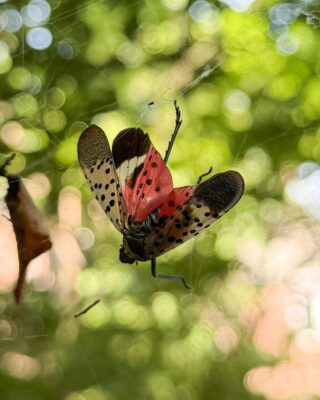
This means that an effective way to manage spotted lanternflies is through controlling the tree of heaven population — a win-win, if you will.
Still, even though the spotted lanternfly can be annoying, our resident entomologist says tolerating their presence can be the easiest strategy for management. However, if you are dealing with a severe spotted lanternfly infestation, here are some resources from the DC Department of Transportation, UMD Extension, and Penn State Extension about how to manage the invasive insect.
TO KEEP OR NOT TO KEEP?
So, how does one cope with the tree of heaven? Is it even worth it to go to battle against a tree that is seemingly unstoppable? Well, it depends.
Like it or not, because the tree of heaven is so pervasive, it is one of the many tree species that make up our urban tree canopy. Additionally, the process for removal is demanding, and getting rid of a mature Ailanthus altissima can rack up quite an expensive bill. This means that removing every tree of heaven from the District is likely not the most sustainable solution, and tree removals should be evaluated on a case-by-case basis.
However, if the tree is a major nuisance (i.e., located next to a garden and has a major infestation of spotted lanternflies), a tree of heaven can — hopefully — be removed. With the guidance of an ISA-certified arborist, here are some steps you can follow to remove your tree of heaven — and plant a noninvasive tree in its place!
STEP ONE: IDENTIFICATION
Firstly, it’s incredibly important to make sure that the tree in question is, in fact, a tree of heaven. Native trees such as the black walnut or staghorn sumac tend to resemble the invasive due to their similar leaves, so it’s important to carefully examine the tree’s bark, flowers, and seeds.
If you look closely, you’ll see that the leaves of walnut and sumac trees have serrated edges while the leaves of the Ailanthus altissima are smooth, except for a few teeth near the base of the leaflet. Don’t be afraid to use your nose to sniff out any rancid peanut butter smell as well!
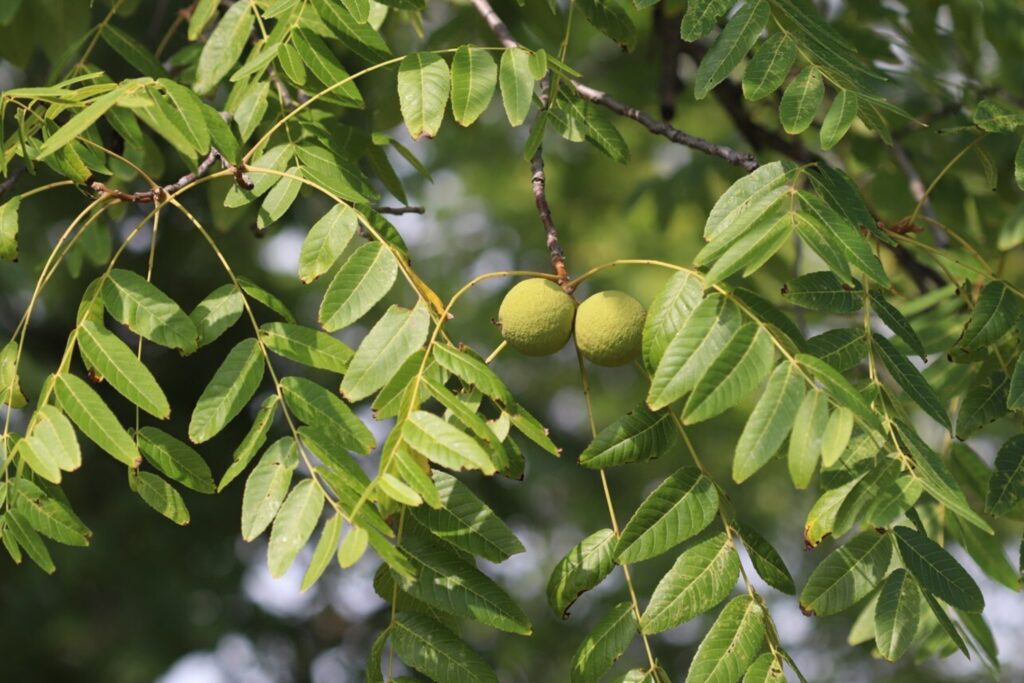
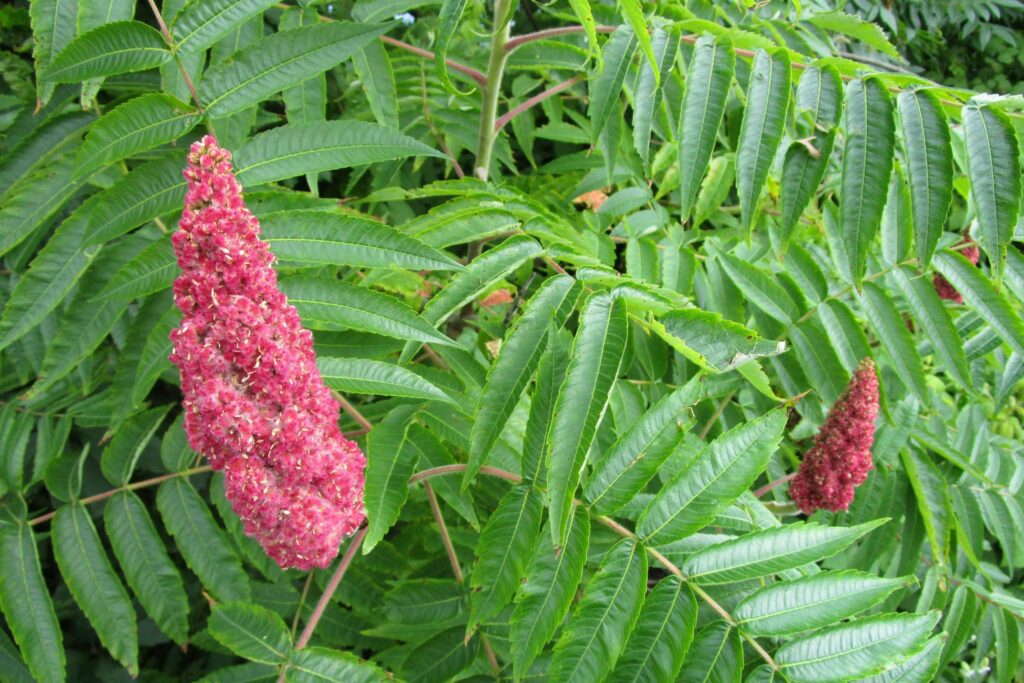
STEP TWO: CALL AN ARBORIST
Due to its incredibly invasive nature, simply cutting down a tree of heaven has little impact. Additionally, hand-pulling young seedlings is only effective before the establishment of a taproot, and only if the entire root system is removed, as even the smallest of root fragments can generate new shoots.
Therefore, an effective method for controlling mature trees is to get help from an ISA-certified arborist to oversee potential herbicide applications. And use caution: the DC Department of Energy & Environment (DOEE) and the District Department of Transportation (DDOT) do not endorse herbicides and insecticides for invasive species control because of the potential negative effect on native species.
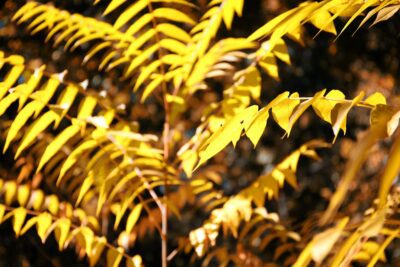
However, if you do decide to use herbicides, timing is key: Penn State and UMD recommend applying herbicide to foliage, bark, or cuts on the stem from July to the onset of fall color. During this period, trees are drawing carbohydrates down into their roots to help them survive the winter — this means that any herbicides applied during this time would also travel down into the root system. If herbicides are applied outside of this time window, only the aboveground growth would be impacted.
Check out this detailed Penn State Extension website for more information on application methods, timing of treatment, and a management calendar.
STEP THREE: POTENTIAL PERMITS AND PLANTING
For those in DC, you may need a permit prior to removal, depending on the circumference of your tree of heaven. However, because of its “weedy” qualities, a large Ailanthus altissima is considered exempt from special and heritage tree removal fees — although you will still need a permit.
You can apply for a tree removal permit through the Transportation Online Permitting System (TOPS). If you do successfully remove a tree of heaven, celebrate by planting a new, noninvasive tree in your yard: Apply for a free tree, or plant a tree yourself and become eligible for a tree rebate!
KEEP CALM AND CARRY ON
Dealing with invasive species can be overwhelming, and it can seem like an uphill battle.

Still, the language we use for invasive species like this can seem dire and borderline militaristic. While we do want to work hard to preserve our native species, it’s important to remember that these insects and plants are a part of our current ecosystem at the end of the day.
Sometimes, tolerating their presence as best we can — or just limiting it — is the most straightforward strategy, especially within the urban context of DC. However, in natural landscapes or rich forests where invasives are often left unchecked, investing the time, energy, and resources into managing the tree of heaven may be a worthwhile expense to preserve our ever-slipping biodiversity.
All that is to say: the tree of heaven is a complicated neighbor. In exploring how to manage it, we seem to have come across a lot of questions. Yet those very questions remind us how we ought to approach our ecosystems — with curiosity, nuance, and a willingness to learn as we consider which species we value and choose to preserve.
